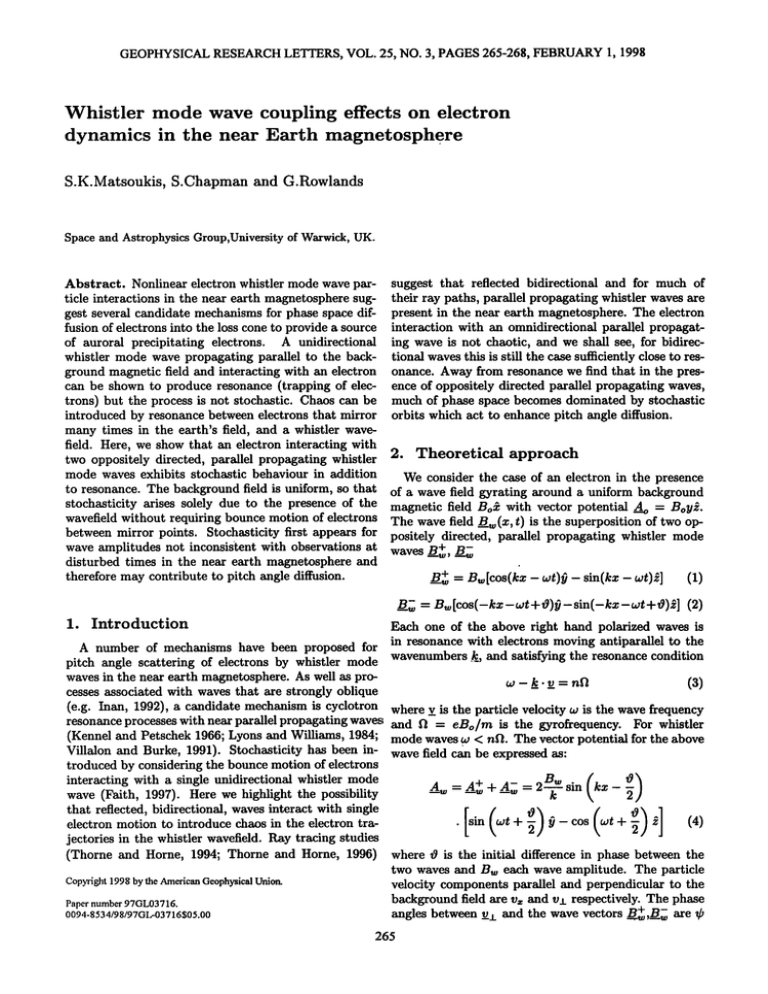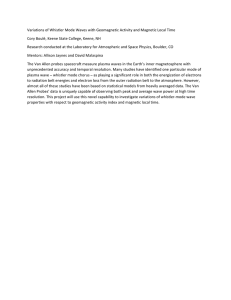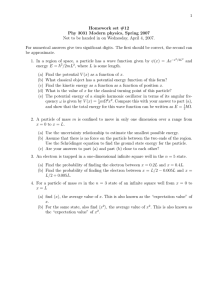Whistler mode wave coupling effects on ... dynamics in the near Earth ...
advertisement

GEOPHYSICAL RESEARCHLETTERS, VOL. 25, NO. 3, PAGES265-268,FEBRUARY 1, 1998 Whistler mode wave coupling effects on electron dynamics in the near Earth magnetosphere S.K.Matsoukis, S.Chapman and G.Rowlands Space and AstrophysicsGroup,University of Warwick, UK. Abstract. Nonlinear electron whistler mode wave particle interactionsin the near earth magnetospheresuggest severalcandidatemechanisms for phasespacediffusion of electronsinto the lossconeto provide a source of auroral precipitating electrons. A unidirectional whistler mode wave propagatingparallel to the backgroundmagneticfield and interactingwith an electron can be shownto produceresonance(trapping of electrons) but the processis not stochastic.Chaoscan be introducedby resonancebetweenelectronsthat mirror many times in the earth's field, and a whistler wavefield. Here, we show that an electron interacting with two oppositelydirected, parallel propagatingwhistler mode waves exhibits stochastic behaviour in addition to resonance.The backgroundfield is uniform, so that stochasticity arises solely due to the presenceof the wavefieldwithout requiringbouncemotion of electrons between mirror points. Stochasticityfirst appearsfor waveamplitudesnot inconsistentwith observations at disturbed times in the near earth magnetosphereand thereforemay contributeto pitch anglediffusion. suggestthat reflected bidirectional and for much of their ray paths, parallel propagating whistler wavesare present in the near earth magnetosphere.The electron interaction with an omnidirectionalparallel propagating wave is not chaotic, and we shall see, for bidirectional wavesthis is still the casesufficientlycloseto resonance. Away from resonancewe find that in the presence of oppositely directed parallel propagating waves, much of phase spacebecomesdominated by stochastic orbits which act to enhancepitch angle diffusion. 2. Theoretical approach We consider the case of an electron in the presence of a wave field gyrating around a uniform background magneticfield Bo& with vectorpotentialA__ o - Boy•. The wavefield B w(x, t) is the superposition of two oppositely directed, parallel propagating whistler mode B•+ = B•[cos(kx- wt)•9- sin(kx- wt)i] (1) B•, = B•[cos(-kx-wt +O)•9-sin(-kx-wt +O)•] (2) 1. Introduction Each one of the above right hand polarized waves is in resonancewith electronsmoving antiparallel to the A number of mechanisms have been proposed for k_,and satisfyingthe resonance condition pitch angle scatteringof electronsby whistler mode wavenumbers wavesin the near earth magnetosphere.As well as pro,• - •. v = nfl (3) cessesassociatedwith wavesthat are strongly oblique (e.g.Inan,1992),a candidate mechanism iscyclotron where v istheparticle velocity wisthewave frequency resonance processes withnear parallel propagating waves and• = eBo/mis thegyrofrequency. Forwhistler (Kennel andPetschek 1966; Lyons andWilliams, 1984;mode waves w < n•. Thevector potential fortheabove Villalon and Burke, 1991). Stochasticityhas been in- wave field can be expressedas: troducedby considering the bouncemotionof electrons interactingwith a singleunidirectionalwhistlermode wave (Faith, 1997). Here we highlightthe possibility that reflected,bidirectional,wavesinteract with single -_Aw++A__• :2•-•Wsin(kx-•) .[sin (•ot +•),0- cos (aJt +•):•] (4) electron motion to introduce chaos in the electron tra- jectoriesin the whistlerwavefield.Ray tracingstudies (Thorneand Horne, 1994; Thorneand Horne, 1996) where 0 is the initial difference in phase between the Copyright1998 by theAmericanGeophysical Union. Papernumber97GL03716. 0094-8534/98/97GL-03716505.00 two waves and Bw each wave amplitude. The particle velocity componentsparallel and perpendicularto the backgroundfield are vx and vñ respectively.The phase angles between vñ andthewavevectors Bw+,B•are•p 265 266 MATSOUKIS ET AL: WHISTLER COUPLING WITH EFFECTS ON ELECTRON DYNAMICS and •b- (2kx - 0), (seeFigure 1). A•b = •- BwlBo=O.001 2kx is the total difference in phase between the two opposite propagatingwaves. The equationsof motion from the Lorentzforcein a coordinatesystemof (v•, vñ, •b) are dvz = -vñfiw[sin(•) + sin(•b- (2kx - •))] dvñ dt (5) = -(v• - •)f•wsin(•b) -(vz+ •)fiwsin(•b(2kx- = ,.,t+ at+ - 0.1 (6) cos() - o)) -3 (7) -I 0 I 2 3 Phase Angle wheref•w = ebb. For Figure 2. For a w = fl/2, Bw = 0.001Bo,the trajectories are regular for a particle of 100 keV. m One obtainsfrom (5) dt 2 -2 + kvñaw[sin(•b) + sin(•b- (2kx- 0))] - 0 (8) where f] is equal to the parallel velocity near resonance. Equation(8) hasthe basicformof the pendulumequa- By substitutingthis value in (9) one finds that this tion wherethe phaseanglesoscillatearoundan equilib- equationis satisfiedif (3) is obeyedand we shall see riumposition, withfrequency w2 = k•wvñ. (8) canbe the resonancesappear in the numericalsolutionsof the full equationsof motion (Figure 2 onwards).Equation expressed in a moresimplifiedway as (9) hasresonances at •b - 0, n7rand at (•b- 7) - 0, --+ kvxaw[sin(•)+ sin(•b- 7)] - 0 (9) n7r. At thesepoints(9) reducesto the pendulumequadt 2 tion of motion of a particle in a singlewave (Dysthe, where if(t)= 2[(a-w)t- q]. (9)canbeexpressed as 1970; Gendrin, 1974).The motion is integrablein this onedegree offreedom system withcoordinates •, •b _ d_• tothese resor d(•-•) dt -dt _ 2(•- W) • •b--7- Close d20 - 2kvñawsin(O)sin(•) =0 (10)onant points couplingwill be weak and the motion is dt 2 whereO = •2 + • - •b. Thisis of theformof a sim- near integrable.As we moveawayfrom resonance the ple pendulumwith a time modulatedlengthor gravita- systemnow has two degreesof freedom•b, 7(t). This tional accelaration. The above pendulum equation can givesthe possibilityfor chaosandenhanced diffusionin be derived from Hamiltonian phasespace,and we will examinethis numericallyin 1 dO the next section. H - •(_•)2+2kvñaw cos(O)sin(•) (11) whichsimplyhasthe formof the standardHamiltonian. 3. We can assumethat around the resonancefixed points, andfor sufficiently smallwaveamplitudes from (5) Numerical Results The regular and stochasticbehaviourof the electron (12) motion is investigatedvia effectivePoincaresurfaceof x = • + fit section plots ofv• = [•-•- (f•-w)]/k,versus •b(see for example Tabor, 1989; Chen, 1992; Ram et al, 1993 and references therein). The plotsare madeby solvingthe v y -k k w • k Figure 1. Coordinate system for a single electron and two oppositelydirected whistler mode waveswith differentwave phases. •b is the phaseangle (rotating equationsof motion forward in time using a variable order, variable stepsizeordinary differential equations integrator (e.g. Chapmanand Watkins, 1993). The surface of section is Vz = 0, where Vz is the z component of the perpendicularvelocity. Each trajectory wasintegrated for 100000gyroperiods,in order to allow particlesto fully exploreall regionsof accessiblephase space. For stochastictrajectoriessignificantdiffusionin phasespaceis foundto occuron tensof electrongyroperiods. All particletrajectorieshavethe sameenergyand phaseangle•b at t = 0 whilst the initial pitch anglewas varied from 0 to 7rgiving 180 setsof initial velocitiesso frame)betweenthe electronperpendicular velocityand the magneticfield vectorof oneof the waves,and a the pitch angle betweenthe electronparallelvelocityand as to coverthe interval[-v•t v•t] wherev•t is the pesothe backgroundmagneticfield vector. MATSOUKIS ET AL: WHISTLER COUPLING WITH EFFECTS ON ELECTRON belowthe typical gyrofrequency of 2 kHz at L-6 (Parrot et al, 1994), the plasmafrequencyat L-6 is around 8 kHz. Electron energiesinvestigatedare in the range 4-100 keV. We find that the particle dynamics is sensitive in the variation of the wave amplitude as well as the particle energy. The changein the dynamicsof electronsof a givenenergy as we increasethe wave amplitude is illustrated in figures2-4, which showPoincareSOS for a 100keV elec- 267 Bw/Bo=0.008 nant v= (seeFigure2). Severalrunswith differentwave amplitudes, particle energiesand wave frequencieshave been performed to investigatethe level of stochasticity in the particle dynamics. Unnormalized, the selected parameters correspond to in the near earth magnetosphere;the range of wave frequenciescoversthe region DYNAMICS 0.15 0.1 •o.: -0.1 -0.15 -3 -2 -1 0 I 2 3 Phase Angle tron. For Bw/Bo - 0.001 the behaviouris essentially regular, that is, it is predictedby the simplependulum Figure 4. Enhanceddiffusionfor Bw = 0.008Bo for a equationof motion. As we increaseBw/Bo to 0.005 100 keV electronand a wavefrequencyof f•/2. (Figure 3) regionsof stochasticityappear, theseallow waveamplitudescorrespond to 100sof pT for L = 6 (ie particlesto explore all phaseanglesand a range of pitch taking 2kHz gyrofrequency)and are within the range angles(that is, a rangeof v= - v cos(a)). Onsetof weak of strongemissionsseenat disturbedtimes (Parrot et stochasticity can be seen just around the separatrices al, 1994) and individual wavepacketsnear the magneof the resonances.At Bw/Bo - 0.008 (Figure 4) we topause(Naganoet al, 1996). The changein the deseestochasticityover significantregionsof phasespace. tailed dynamics of the particles with frequencyis comThe particle motion is still regular closeto resonance, plex and will be adressedin a future paper. Here we and particles cannot diffuse between the regions surnote that the waveamplitude at which stochasticityfirst rounding the resonancesassociatedwith the forward appears in phase spaceis similar to within an order of and backwardpropagatingwaves.If weincreaseBw/Bo magnitude. We also anticipate that the more realistic further then phase spacediffusionbecomesglobal and situationwhereseveralwavemodesare considered (and stochastic particles can move acrossv• - 0. that the wavenumbersof the oppositely directed waves Changeof the relative phasebetweenthe wavesdoes are not the same)will increasethe complexityof the denot affect this behaviour qualitatively, simply moving tailed dynamics;this is beyond the scopeof this initial the location of the resonancesas we would expect from study and will be adressedin future. equation(9)(seeFigure5). Finally, Figure 6 showsthat the particle energy osThis behaviour is qualitatively the same for differcillates with time so that the net energy changeis zero. ent electronenergiesin that there will be a threshold Hence, this Wave Particle Interaction mechanismwill valuefor Bw/Bo whenstochasticity appears;however lead to pure pitch angle diffusion rather than particle the value of this thresholdis energydependent. These energization. BwlBo=0.005 0.15 -2 -1 0 I 2 3 Phase Angle Figure 3. Diffusion around the separatricesfirst appears for Bw -• 0.005Bo, shownfor electronenergyof 100 keV and wavefrequencyof f•/2. -3 -2 -1 0 I 2 3 Phase Angle Figure 5. Effect of varying the phasebetweenthe two waves,for a 100 keV electron,wavefrequencyw - f•/2, Bw - 0.008Bo and ½ - •2' 268 MATSOUKIS ET AL: WHISTLER COUPLING WITH EFFECTS ON ELECTRON DYNAMICS Acknowledgments. This work was conducted whilst S.K.Matsoukis was partially supportedby PPARC. References Chapman,S.C., and Watkins,N.W.,Parametarization of chao tic particle dynamicsin a simple time-dependantfield reversal,J.G eophys.Res.,98,165,1993. Chen,J.,NonlinearDynamicsof ChargedParticlesin te Magnetotail, J.Geophys.Res.,97,15011,1992. Devine,P.E., and Chapman,S.C.,Selfconsistentsimulation studiesof nonlinear electron whistler wave particle interactions,PhysicaD.,95,35,1996. Dysthe,K.B.,Some studies of triggered whistler emissions, 0 500 1000 1500 2000 2500 3000 3500 J.Geophys.Res., Time 76,6915,1971. Figure 6. Dependenceof the particle energy on time Faith J.,Electron precipitation causedby chaotic motion in the magnetosphere due to largeamplitudewhistlerwaves, for Bw - 0.008Boand w - f•/2, showingthat the net J. Geophys. Res.,102,2233,1997. particle energyremainsconstant. Gendrin,R., Phase-bunching and other non-linearprocesses occurring in Gyroresonant Wave Particle Interac- tions, 4. Conclusions Astrophys. and SpaceSci.,28,245,1974. Kennel,C.F., and H.E. Petscheck,Limiton stably trapped It has been shownthat couplingbetweentwo oppoparticle fluxes, J.Geophys. Res., 71, 1, 1966. sitely propagatingwhistler mode wavesof the sameam- Inan,U.S., Gyroresonantpitch angle scattering by coherent and incoherentwhistler wave modesin the magnetoplitude and wavenumbercan lead to stochasticelectron sphere,J.Geophys.Res.,92,127,1987. dynamics. Specifically,it is shownthat chaoticphenomLyons,L.R. and Williams, D.J., Quantitative Aspects of ena occur due to the presenceof the secondwave. For MagnetosphericPhysics,D. Reidel, Hingham, Mass., 1984. sufficientlysmall wave amplitudes, however,the devia- Nagano, I.,Yagitani, S., Hirotsugu, K. and Matsumoto, H., tions from the singlewhistler mode waveelectroninterAnalysis of Wave Normal and Poynting Vectors of the actionsis not significantand the motion of the particle in phase space can be consideredas identical to that of a simple pendulum. As the amplitude increasesthe effectsof the other wave on the particle by means of the Lorentz force become important, the integrals of motion are not conservedand regular dynamics can be maintained only in the vicinity of resonances;the KAM surfacesbreak up successively.It is also found that the value of the wave phase does not changethe electron dynamics in a qualitative manner. Chaotic dynamics of electronsmay allow significantpitch angle scattering into the losscone(phasespacediffusion)in the magnetosphereunder certain circumstances.Results suggest that for example for 100 keV electrons,stochasticityis evident for wave amplitudes observedat L - 6 during ChorusEmissionsobservedby GEOTAIL,J.Geomag. Geoelectr., 48,299-307,1996. Parrot,M. and Gaye,C.A., A statistical surveyof ELF waves in geostationaryorbit,Geophys.Res.Letters, 23,2463-2466, 1994. Ram, A.K., Bets, A.,Hamiltonian chaos in Wave Particle Interactions, Phys. of Space Plasmas,13,341,1993. Tabor,M.,Chaos and Integrability in nonlinear dynamics: An Introduction(Jonh Wiley, New York, 1989). Thorne R.M., and Horne,R.B., Landau damping of magnetosphericallyreflectedwhistlers,J.Geo-phys.Res.,99,17249, 1994. Thorne,R.M., and Horne,R.B., Whistler absorptionand electron heating near the plasmapause,J.Geophys. Res.,101, 4917, 1996. VillaIon, E., Burke, W.J.,Rothwell,P.L., and Silevitch,M.B., Quasi-linear wave particle interactionsin the Earth's radiation belts,J.Geophys.Res., 94, 15243,1989a. disturbed times. VillaIon, E., Silevitch, M.B., Burke, W.J.,Rothwell, P.L., Gyroresonant interaction of energetic trapped electrons The diffusioncoefficientfor the processdiscussedhere will be calculated in a future paper. However, we an- and protons,in Physicsof SpacePlasmas(1989),SPI Con. Proc.Reprint Set., vol.9,edited by T.Chang, G.B.Crew, ticipate that pitch anglediffusionwill scaleas the local and J.R. Jasperse,p.365,Scientific,Cambridge,Mass., gyrofrequency.This is to be comparedwith stochas- 1989b. tic diffusiondue to bounceresonance(e.g. Faith et al, Villalon,E.andBurke,W.J.,Near-Equatorial PitchAngleDif- 1997)ofelectrons withwhistler modewaves whichwill fusion ofEnergetic Electrons byOblique Whistler Waves, scale withthebounce frequency, thismaybereflected J.Geophys. Res.,96,9655,1991. in the muchlarger waveamplitudesrequiredin Faith et Space and AstrophysicsGroup, University of Warwick, al 1997fordiffusion. Also,thereissome evidence that UK this processwill still occurwhenthe fieldsand electron motionare evolvedselfconsistently (Devineand Chap- (Received August25, 1997; revisedNovember 6, 1997; man,1996). accepted November 28,1997.)








